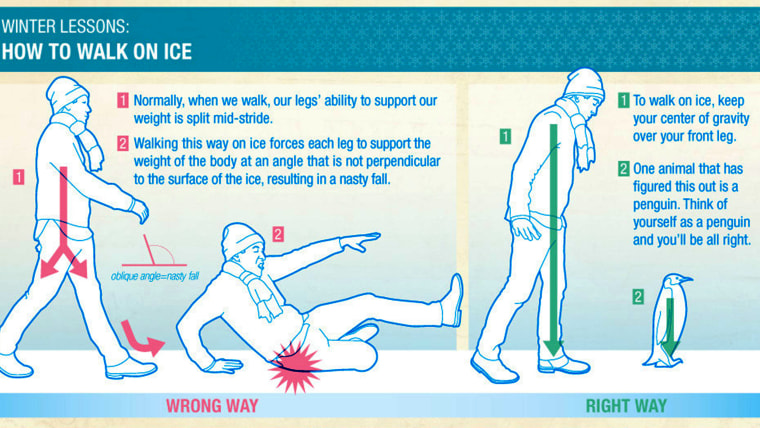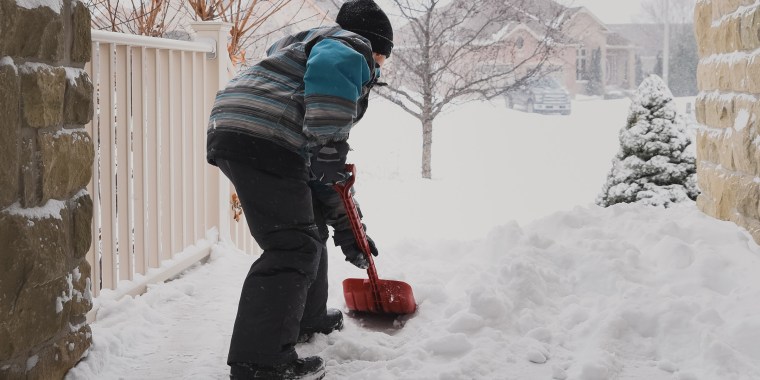More than 100 million people across 17 states woke up to a visit from Orlena, the winter storm pummeling the Northeast with strong winds, heavy snow and ice.
Hopefully you can hunker down and wait out the storm warm and cozy on the couch (there's one upside of quarantine). But when it's time to dig yourself out, doing it safely is key.
One study found that there are an estimated 11,500 snow shovel-related injuries and medical emergencies treated in the U.S. each year. Here's what the experts want you to know about staying safe and protecting the most vulnerable parts of your body while shoveling snow.
Heart
Pace yourself, shoveling for 15 to 20 minutes at a time.
Because shoveling is an upper body workout, it's a harder strain on your heart than walking or other cardio, said Dr. Jon Rittenberger, an associate professor of emergency medicine at the University of Pittsburgh School of Medicine.
Be aware of heart attack warning signs: increased heart rate, shortness of breath, more sweating and tightness in the chest.

Lower back
According to Adam Bornstein of Born Fitness, most back issues stem from one problem: poor core strength.
Fixing your form is usually a matter of one simple adjustment:
- Don't round your lower back. Once you do, you shut off the powerful muscles that make shoveling easy and shift the stress onto small muscles that cause all of your pain.
Instead of rounding:
- Focus on pushing your hips backward while slightly bending your knees. You want your core and abs, as well as your hips and hamstrings, to provide stability for your lower back.
- Avoid twisting in unnatural positions to throw snow to the side, or even over your shoulder, according to the American Academy of Orthopaedic Surgeons. The twisting motion is dangerous for your back. If you absolutely must move the snow over, adjust your feet so they're facing the direction that the snow must go.
Pro tip: squeeze that core!
Shoulders
Do not lift the snow. Push it!
According to the American Academy of Orthopaedic Surgeons, you should:
- Tightly grip the shovel, while concentrating on keeping the tool close to your body as you push.
- If you have to lift, make sure your feet are at least shoulder width apart, and bend at the knees.
Biggest mistake? Bending at the waist or back.
Toss the snow aside at waist level to better protect the shoulders. Keep the snow in front of you. Squat down with the shovel, pick it up while standing up, engaging the leg muscles and turning the entire body to toss the snow.
Wrists
Wrist problems typically result from back issues, according to Bornstein.
Think about it — once you break the foundation, your body tries to compensate with other muscles that are smaller and shouldn't be as involved with the heavy lifting, like your wrists.
Most wrist injuries probably occur from not stabilizing your wrist before you start lifting snow that might be heavier than it appears.
- Grip as tight as possible and have a good hold. Wear gloves, because if your hands are too cold, that will affect your grip. "Similarly, if your gloves are too bulky, your shovel is probably harder to hold," said Bornstein.
Keep in mind your wrists should not be doing the heavy lifting. If you find yourself bending or twisting your wrists in the movement, you're opening yourself up to the possibility of injury, Bornstein said.
Skin
Wear layers, making sure your nose, toes and fingers are well covered and dry. Frostbite affects these appendages first.
In subzero temperatures, frostbite occurs in less than 30 minutes. “If it is 28 or 30 degrees outside, it'll take longer,” Rittenberger said. “Once you are wet, the water helps dissipate heat from the body even faster; that is the disadvantage of being out in the cold [snow].”
The American Academy of Orthopaedic Surgeons offers more safe shoveling logistics:
- Shovel at the start of snowfall, and continue frequently. Partially melted snow and heavily packed snow will be tougher to remove down the line, so try to begin shortly after fresh snow has fallen.
- Use the right shovel for YOU. If it feels uncomfortable and doesn't match your height or strength, find a different one. Ergonomically designed snow shovels — a version with a curved handle — help reduce spinal stress.
- Start slow. Don't exhaust yourself. Stay hydrated and take frequent breaks. It's cold out, so perspiration often goes unnoticed. Take regular water breaks.
Information from this post was compiled from Dr. Jon Rittenberger and the American Academy of Orthopaedic Surgeons.
This is an updated version of a story that was published in January 2016.


